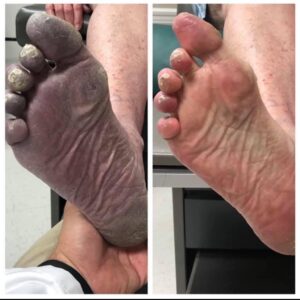
Improving Peripheral Neuropathy Symptoms
Given the impact of neuropathy on the quality of sufferer’s lives, improving peripheral neuropathy is more than just a desire, it’s a medically legitimate need. This condition that affects millions of people worldwide, causing damage to the peripheral nerves, which are responsible for transmitting signals between the brain and spinal cord to the rest of the body. It often leads to symptoms such as numbness, tingling, weakness, and pain in the hands and feet. While there is no known cure for peripheral neuropathy, there are several ways to manage its symptoms. One particularly effective approach is incorporating exercise and physical activity into your routine. In this blog post, we will explore how exercise can positively impact peripheral neuropathy and provide practical tips for getting started.
Understanding Peripheral Neuropathy
Peripheral neuropathy refers to the damage or dysfunction of the peripheral nerves, which transmit information between the central nervous system and the rest of the body. This damage can result from various causes, including diabetes, vitamin deficiencies, autoimmune diseases, infections, and exposure to toxins. The nerve damage disrupts the normal functioning of the peripheral nervous system, leading to discomfort and impaired mobility.
The Role of Exercise in Managing Peripheral Neuropathy Symptoms
Exercise offers a range of benefits that can help individuals by improving peripheral neuropathy leading to a better quality of life. Here are some ways in which physical activity can improve peripheral neuropathy symptoms:
- Improved Blood Circulation: Exercise increases blood flow to the extremities, enhancing the delivery of oxygen and nutrients to damaged nerves. It helps repair and regenerate nerve tissues, reducing symptoms like numbness and tingling.
- Pain Reduction: Engaging in regular exercise triggers the release of endorphins, which are natural painkillers. These endorphins help alleviate neuropathic pain and improve overall pain tolerance.
- Enhanced Balance and Coordination: Peripheral neuropathy often affects balance and coordination, increasing the risk of falls. Participating in activities that improve strength and stability, such as yoga and tai chi, can help restore balance and reduce the likelihood of accidents.
- Weight Management: Maintaining a healthy weight is crucial for managing peripheral neuropathy symptoms, especially for those with diabetes-related neuropathy. Regular exercise and a balanced diet can aid in weight loss or maintenance, leading to improved blood sugar control and reduced nerve damage.
- Stress Reduction: Living with peripheral neuropathy can be mentally and emotionally challenging. Exercise serves as a powerful stress reliever, releasing tension and promoting relaxation. It can also boost mood and improve overall mental well-being.
Practical Tips for Incorporating Exercise
When it comes to exercising with peripheral neuropathy, it’s important to start slowly and gradually increase the intensity and duration of your workouts. Here are some practical tips to help you get started:
- Consult Your Healthcare Provider: Before beginning any exercise program, it’s crucial to consult your healthcare provider or a qualified physical therapist. They can evaluate your condition, provide personalized recommendations, and ensure your safety during physical activity.
- Choose Low-Impact Activities: Opt for exercises that are gentle on the joints and nerves, such as walking, swimming, cycling, and water aerobics. These activities minimize the risk of injury and help you gradually build endurance.
- Warm Up and Cool Down: Prioritize warm-up and cool-down exercises to prepare your muscles and reduce the risk of muscle strains or injuries. Gentle stretches can help increase flexibility and improve circulation to the affected areas.
- Focus on Strength and Balance: Incorporate strength training exercises into your routine to improve muscle tone and stability. Resistance bands, light weights, or bodyweight exercises can help strengthen muscles without placing excessive stress on the joints.
- Listen to Your Body: Pay attention to any discomfort or pain during exercise. If you experience increased symptoms or unusual sensations, modify your activity level or seek medical advice.
- Consider Therapeutic Options: In addition to traditional exercises, complementary therapies like acupuncture, massage, and physical therapy may also benefit individuals with peripheral neuropathy. These treatments can help alleviate pain, reduce inflammation, and enhance overall well-being.
While peripheral neuropathy may pose challenges in daily life, incorporating exercise and physical activity into your routine can significantly improve your symptoms and overall well-being. By enhancing blood circulation, reducing pain, improving balance, and managing weight, exercise serves as a powerful tool for managing this condition. Before starting any exercise program, remember to consult your healthcare provider or one of our experts at Elevation Health Center, and tailor your activities to your specific needs. With commitment and patience, you can take proactive steps to alleviate the impact of peripheral neuropathy on your life and regain control of your health.



